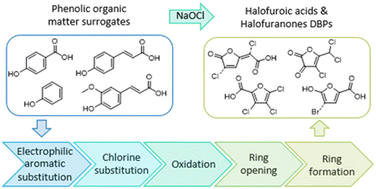The formation of furan-like disinfection byproducts from phenolic precursors†
Abstract
In this study, it was hypothesised that UV-absorbing disinfection byproducts (DBPs) may include compounds, such as halofuranones, prioritized as candidates for explaining the increased risk of bladder cancer associated with the consumption of chlorinated water highlighted by epidemiological studies. Hence, UV spectroscopy was used as a screening method to identify conditions forming stable UV-absorbing DBPs from 10 phenolic precursors at various pH levels, chlorine and bromide doses. Subsequently, high performance liquid chromatography coupled to high resolution mass spectrometry (Orbitrap™) was used to elucidate the chemical formulas of 30 stable DBPs, 12 of which were tentatively identified as furan-like structures, including trichlorofuran-2-carboxylic acid, dichlorofuran-2-carboxylic acid, 3,4-dichlorofuran-2,5-dicarbaldehyde, 4-chloro-5-(dichloromethyl)furan-2,3-dione, 5-formyl-2-furancarboxylic acid, chloro-5-methyl-2-furancarboxylic acid, 2-acetylchlorofuran-5-one and bromo-2-furancarboxylic acid. Eleven of the furan-like structures are previously unknown as DBPs. A novel pathway was proposed to explain their formation, involving the opening of the oxidised phenolic ring followed by the formation of a 5-membered ring by intramolecular nucleophilic addition. Of the 12 furan-like DBPs identified, eight and three were respectively predicted to be mutagens and bladder carcinogens, using a quantitative structure–activity relationship theoretical model. The findings indicate the formation of furan-like DBPs from natural organic matter surrogates is more widespread than previously appreciated. Moreover, this class of DBPs may be toxicologically significant for the urinary bladder.

- This article is part of the themed collection: Recent Open Access Articles


 Please wait while we load your content...
Please wait while we load your content...